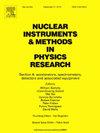A model-independent method for mitigation of pileup artefacts in energy-resolved radiation counting
IF 1.5
3区 物理与天体物理
Q3 INSTRUMENTS & INSTRUMENTATION
Nuclear Instruments & Methods in Physics Research Section A-accelerators Spectrometers Detectors and Associated Equipment
Pub Date : 2025-02-05
DOI:10.1016/j.nima.2025.170276
引用次数: 0
Abstract
This article presents a model-independent post-processing method to restore the counting and spectral information of pulse-height analyzers in the presence of pulse pileup at high counting rates. The method is based on the measurement of counts and of the integral durations of the detector signals over different thresholds, and on the comparison of the measurements from two sources with the same energy distribution and different counting rates . The procedure does not require the modeling of the pulse shape, the knowledge of the dead-time or other parameters. The correction technique was validated with simulations and with spectra of high activity gamma sources collected with a high-purity germanium (HPGe) detector. For a simulated flat energy distribution and a ratio 2 between the two counting rates, the relative mean deviation between the corrected and input spectra is less than 1% and the relative standard deviation below 5% up to a normalized input rate . These results improve by increasing the difference between the input rates of the two sources. In the simulation of an X-ray spectrum at a normalized input rate , the ratio between the number of corrected and generated counts in each energy bin is below a few percent. The experimental validation was performed by acquiring two spectra of Am sources of different activities placed in a fixed position and of a high activity Cs source placed in two different position. In both cases, the correction method provides count rate distributions in close agreement with a reference spectrum from a lower activity source. The mitigation of artefacts in HPGe spectra overcomes the performance of a standard pileup rejection method.
求助全文
约1分钟内获得全文
求助全文
来源期刊
CiteScore
3.20
自引率
21.40%
发文量
787
审稿时长
1 months
期刊介绍:
Section A of Nuclear Instruments and Methods in Physics Research publishes papers on design, manufacturing and performance of scientific instruments with an emphasis on large scale facilities. This includes the development of particle accelerators, ion sources, beam transport systems and target arrangements as well as the use of secondary phenomena such as synchrotron radiation and free electron lasers. It also includes all types of instrumentation for the detection and spectrometry of radiations from high energy processes and nuclear decays, as well as instrumentation for experiments at nuclear reactors. Specialized electronics for nuclear and other types of spectrometry as well as computerization of measurements and control systems in this area also find their place in the A section.
Theoretical as well as experimental papers are accepted.

 求助内容:
求助内容: 应助结果提醒方式:
应助结果提醒方式:


